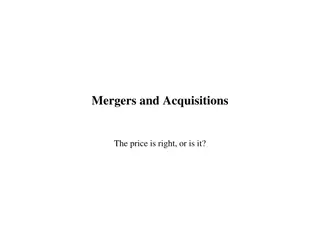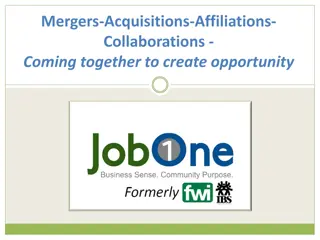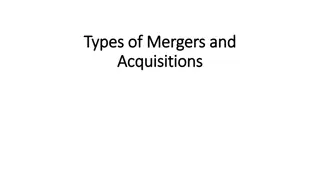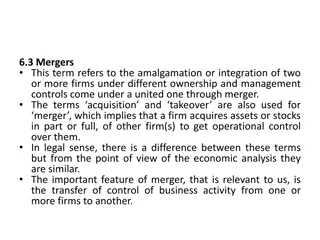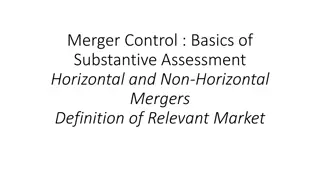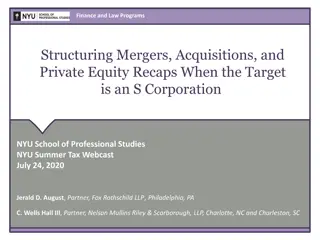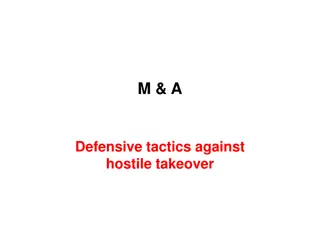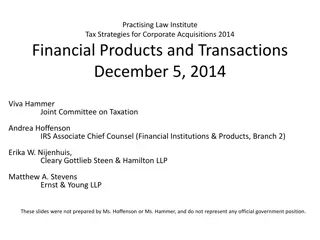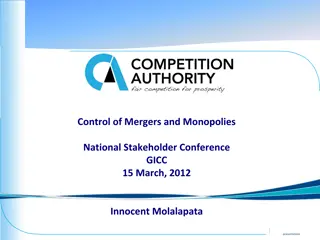Understanding Strategic Alliances vs. Mergers & Acquisitions in Corporate Dynamics
Exploring the concepts of strategic alliances and M&As in the corporate world. Strategic alliances involve formal relationships between companies with shared goals, while M&As combine companies to varying degrees. Motivations for entering alliances include technology development, market access, and competitiveness. Learn how these strategies differ and impact company structures.
- Strategic Alliances
- Mergers & Acquisitions
- Corporate Dynamics
- Collaborative Relationships
- Business Partnerships
Download Presentation

Please find below an Image/Link to download the presentation.
The content on the website is provided AS IS for your information and personal use only. It may not be sold, licensed, or shared on other websites without obtaining consent from the author. Download presentation by click this link. If you encounter any issues during the download, it is possible that the publisher has removed the file from their server.
E N D
Presentation Transcript
Welcome to Session 8 Corporate Mergers & Acquisitions
What are Strategic Alliances & What are Strategic Alliances & How do they differ from M&As? How do they differ from M&As?
Strategic Alliances Strategic Alliances Are: Formal relationships between two or more corporations with a mutual set of goals. They offer Competing companies' unique opportunities to prosper through collaborative efforts rather than competing activities.
COLLABORATIVE vs. COMPETITIVE Strategic Alliances Strategic Alliances Three most common Strategic Alliances are: (1) Licensing arrangements: greatest individuality (2) Joint ventures: more closely align the two firms (3) Cross-holding arrangements (CHAs): most complex [with CHAs, each company takes equity stakes] Strategic Alliances do not transform either company into a new company. Each firm remains completely independent.
What motivates companies to enter into strategic alliances or cooperative arrangements? To expedite the development of promising new technologies or products. To bring together the personnel and expertise needed to create desirable new skill sets and capabilities to improve supply chain efficiency, and/or gain economies of scale in production and/or marketing. To acquire or improve market access through joint marketing agreements. To help win the race against rivals for global market leadership.
Now let's look at Mergers & Acquisitions (M&As) Mergers & Acquisitions (M&As) Mergers & Acquisitions are very different from Strategic Alliances and Mergers are very different from Acquisitions
Strategic Alliances DO NOT COMBINE Companies Mergers & Acquisitions DO COMBINE Companies However, Mergers are NOT the same as Acquisitions However, Mergers are NOT the same as Acquisitions
Okay, how do Mergers differ from Acquisitions? Mergers = two firms become one new firm. Original stock is dissolved, and new stock is issued. Acquisition = one firm absorbs another. Seller firm stock ceases to exist. Buyer firm stock continues.
MERGER = COMBINE ACQUISITION = TAKE CONTROL
1. Merger 1. Merger = Combine = Combine A merger describes two firms of approximately the same size, combining into one. This is often referred to as a "merger of equals." The stock of both firms is surrendered, and stock of the new entity is issued in its place. Generally, mergers are separated into one of three forms. 1. Horizontal merger -- one firm mergers with another duen that provides similar products and/or services in the same geographic area For example, this is done to become larger with more bargaining power 2. Vertical Merger -- One in which involves the coupling of a customer and a supplier. For example, this is often done to gain better access to end users and better market visibility 3. Conglomerate mergers encompass all other combinations, including pure conglomerate transactions where the merging parties have no evident commercial relationship. For example, Internet company merges with a chain of restaurants.
2. Acquisition = Obtain/Take control In a simple acquisition, the acquiring company obtains the majority stake in the acquired firm. The acquired firm ceases to exist, while the legal status and formal name of the acquiring firm rarely changes. As in the case of a merger, acquisitions are divisible into Horizontal, Vertical, and Conglomerates. However, they can be further separated into 1. Hostile (not welcome by takeover target) 2. Friendly (or invited) (welcome by takeover target)
M&As can have different master strategies: M&As can be in fields that are: Closely related: Strategy strengthen competitive advantage within strategic group Somewhat related: Strategy strengthen competitive advantage by extending beyond current strategic group Unrelated related: Strategy strengthen competitive advantage by diversifying into new industries.
Some M&A strategic objectives can be similar to those of strategic alliances. 1. To expedite the development of promising new technologies or products. (New knowledge and innovative energies) 2. To transition into new lines of business 3. To bring together the personnel and expertise needed to create desirable new skill sets and capabilities to improve supply chain efficiency, and/or gain economies of scale in production and/or marketing. 4. To acquire or improve market access through joint marketing agreements. 5. To help win the race against rivals for global market leadership. 6. To Grow Revenue. 7. To reduce costs through synergy. 8. To produce a STRONGER balance sheet. 9. To expand leverage with suppliers.
However, M&As have a disappointing history Despite the potential benefits of M&As, they fail at a staggering rate failed to achieve stated objectives at an astonishing rate of almost 80% of the time. In fact, a recent study concluded that merger and acquisition events have dollars in lost value to companies and shareholders. The extraordinarily high failure rate of M&As can translate into billions of reveals the magnitude of potential risks. Even a cursory review of high-profile M&A collapses from recent decades
2020 Merger Attempts gone wrong: 2020 Merger Attempts gone wrong: Cigna and Anthem Cigna Corp. and Anthem, Inc. attempted a $48 Billion merger deal Disagreements emerged Cigna sued Anthem for $14.7 plus a $1.8 Billion breakup fee Anthem countersued Cigna for $21.1 Billion
If they have such a If they have such a disappointing history, disappointing history, Why do CEOs champion them? Why do CEOs champion them?
Why do they do it? If the failure rate is so significant, why do CEO s champion M&A Activity? Shareholder Interest Research suggests there are three (3) primary motivators: M&A Personal Interest Hubris or Ego
CEO Motivations for promoting M&As (1) CEO s personal values motivate a desire to deliver maximum value to shareholders. for example, counsel is pursued, due diligence is performed, and the final decision is vetted by the CFO and the Corporate Board of Directors. (Does not seek unrestrained Discretion) (2) CEO s personal values motivate a desire to serve personal interest. for example enriching compensation or by empire building. (Seeks unrestrained Discretion) (3) CEO s personal values motivate a desire to feed an oversized ego. CEO is excessively self-confident, hubristic, and demonstrates a sense of personal infallibility (Seeks unrestrained Discretion) for example: It s my idea so it cannot go wrong, there is little need for discussion. What can go wrong in Corporate structures that facilitate unrestrained CEO discretion?
FOOLISH CEO decisions can corporate board do anything to stop the nonsense? Go ahead FOOL!
How can CEO discretion be moderated? How can CEO discretion be moderated? How can they be forced to listen? How can they be forced to listen? Two primary moderators of CEO discretion 1. Proactive Corporate Board of Directors (BoD) Responsibility: Oversight of CEO proposed strategies 2. Proactive Chief Financial Officer (CFO) Responsibility: Protect the firm from unreasonable financial risks
What is the benefit of CEO discretion moderators? When Corporate Boards and CFOs are PROACTIVE and exercise due diligence in approving CEO M&A Proposals -- Performance is likely to improve
Questions? Questions? Be sure to ask next time
End Session 8: Corporate Mergers & Acquisitions & Strategic Alliances Study for test one However, DO NOT FORGET TO BRING YOUR LAPTOP computer to the class following the test! THINK REMEMBER! This is EXTREMELY IMPORTANT


